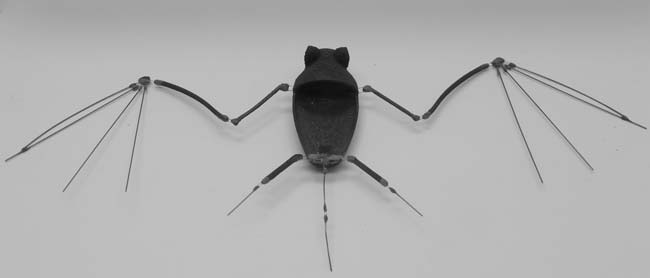Robotic Bat: A Sneaky Spy

A palm-sized "robo-bat" with shape memory alloy jointed limbs and smart material alloy muscles is being built by North Carolina State University researchers. It's the perfect micro air vehicle (MAV) for surveillance or other kinds of data gathering — Batman could fit this gadget easily onto his utility belt.
Gheorghe Bunget, a doctoral student in mechanical engineering at NC State, and his advisor Dr. Stefan Seelecke looked to nature for inspiration. "We are trying to mimic nature as closely as possible," Seelecke says, "because it is very efficient. And, at the MAV scale, nature tells us that flapping flight – like that of the bat – is the most effective."
According to the NC State press release, the fully assembled robotic 'bat' skeleton rests easily in the palm of your hand and, at less than 6 grams, feels as light as a feather.
The research team is using a special shape memory alloy that is super-elastic for the joints of the robo-bat. The material offers a full range of motion, but always returns to its original gliding position. These materials have many uses; it is even possible to make a 'soft' robot powered by shape memory alloy spokes.
Smart materials are also being used for the 'muscles' on the robotic bat. Seelecke explains:
"We're using an alloy that responds to the heat from an electric current. That heat actuates micro-scale wires the size of a human hair, making them contract like 'metal muscles.' During the contraction, the powerful muscle wires also change their electric resistance, which can be easily measured, thus providing simultaneous action and sensory input. This dual functionality will help cut down on the robo-bat's weight, and allow the robot to respond quickly to changing conditions – such as a gust of wind – as perfectly as a real bat."
It's interesting that science fiction writers also chose to mimic nature in the earliest descriptions of robotic MAVs. I was thinking in particular about the extraordinary Scarab flying insect robot from Raymond Z. Gallun's The Scarab, published in Astounding Stories magazine in 1936.
Sign up for the Live Science daily newsletter now
Get the world’s most fascinating discoveries delivered straight to your inbox.
"The Scarab rubbed its hind legs together, as flies will do when at rest. Then, apparently satisfied that it was in condition, it unfolded the coleoptera-like plates over its wings. With a buzz that any uninformed person would have mistaken for that of a beetle, it started out on its journey." (Read more about the scarab flying insect robot)
For a different take on the idea of a robotic bat by a different research team, take a look at the COM-BAT Robotic 'Bat' On Order From UM . The development process for this tiny MAV emphasizes the senses of a robotic bat.
- Video: See Bats in Flight
- Freaky Robot Is a Real Einstein
- More Robot News
This Science Fiction in the News story used with permission of Technovelgy.com.
{{ video="080228-bats.flv" title="Bats in Flight" caption="See bats flying and hovering in a wind tunnel. Credit:F.T. Muijres, Lund University" }}










